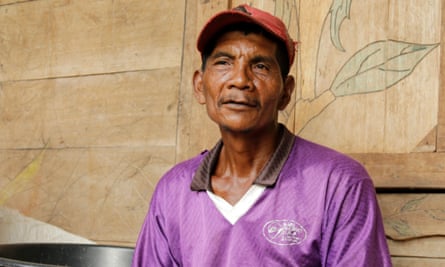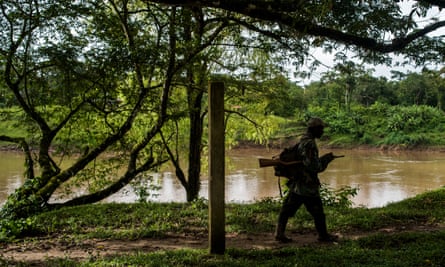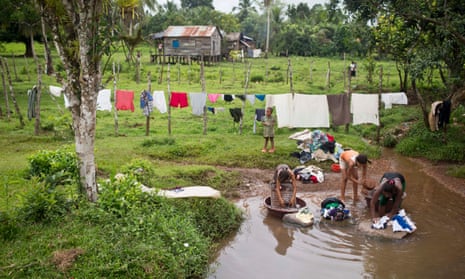Santiago Vásquez’s seven children are hungry. It has been months since he last went to his field. Tending crops has become a dangerous endeavour along Nicaragua’s eastern coast.
Since 2015, dozens of men in the area from the Miskito indigenous people – and other groups, including the Rama and Ulwa – have been killed, women have been raped and families taken captive on the way to their farms, hunting or fishing, according to Cejudhcan, an NGO defending the rights of indigenous people in the region.
When the bodies of two men from the community of Esperanza Río Coco were found dismembered last August, Vásquez stopped going to his field. “My farm is a two-and-a-half hour walk away. I had cattle, pigs and chickens there, but because of the settlers, I had to abandon it all. I don’t have a good gun to defend myself,” he says.
Increasing violence has been fuelled by the promise of cheap virgin land, precious timber and gold, which has lured people to the lush tropical rainforests. The new settlers are mestizos, Nicaraguans of mixed Spanish-native American descent.
“In 2004, there were 44 settler families on the Awas Tingni territory. In 2012 it was 475. The number has increased considerably in 2014, with some institutes speaking of more than 800 families. And this is just one territory,” says Lottie Cunningham, a human rights lawyer and founder of Cejudhcan.
Nicaragua was a pioneer in granting significant land rights to native people. There are 23 indigenous territories stretching across 24,000 square miles and they are home to more than 200,000 indigenous people. The law bans the sale of indigenous land.
When the newcomers began to outnumber locals, the Miskitos, who had long tolerated the presence of mestizos on their territories, demanded they leave. Violence erupted, with victims on both sides.
“[The Miskitos] have sold us the land, but they don’t honour the deals. They want us to pay them over and over again,” says Alfredo Montiel, a member of a mestizo farmers’ association formed in response to the land conflict. “If we refuse, they want to evict us.”

Mestizo farmers accuse Miskitos of appearing to sell them land, when they are actually selling permits. Some farmers are unaware that the sale of land is illegal, others are not.
Miskitos admit some people have acted corruptly and have called for an investigation. “If there are indigenous people involved in this, they should be punished,” says Cunningham. “There shouldn’t be a whole community suffering.”
Publicly, the government has sided with the Miskitos. In 2013, it created an inter-institutional commission, chaired by the prosecutor general, to tackle the issue. It has dismissed several public registrars and arrested lawyers and public notaries involved in the sales of indigenous lands. The investigation has implicated prominent opposition politicians.
There is a suspicion that, despite the official discourse, the government is secretly in favour of the settling. “Ex-president Arnoldo Alemán was the first to support the invasion of settlers into the Caribbean coast in order to satisfy farmers’ demands for land and to win political capital in the regions. The invasions would continue during the governments of Enrique Bolaños and the commander Daniel Ortega,” says Gilles Bataillon, a French sociologist who has studied conflicts in the region.
Some believe that the Miskitos, with their subsistence farming, do not value the development potential of the area. Mestizos, on the other hand, engage in large-scale cattle farming. With beef being one of Nicaragua’s main exports, the settlers make a substantial contribution to Nicaragua’s GDP.
The Miskitos believe this is partly why the government has allowed the violence on the Caribbean coast to continue unabated.
The government has ignored calls from the Inter-American Commission for Human Rights to adopt measures to protect Miskitos. The two men from Esperanza were decapitated just a few days after the commission’s third request.
Last September the Inter-American Court of Human Rights ordered Nicaragua to protect the indigenous people. The government response said a new military base on the Coco river looks after the communities.
The sister of Gerardo Chale, one of the decapitated men, is bitter about such protection. “When my brother was kidnapped I went to the military base in Wasput Ta to ask them to come with us to search for him. They said they were not authorised to help us,” says Lina Chale.

Both Miskitos and mestizos claim there has been no investigation into the crimes, and police often refuse to register their complaints. “The government told the court that it has received no complaints regarding the land conflict. That all the 2,000-and-something complaints registered in 2015 on the Caribbean coast were common crimes,” says Cunningham. “This means that they do not want to classify these murders, disappearances and kidnappings as a land conflict.”
Neither the police nor the army responded to requests for comment.
Meanwhile, hunger among the indigenous communities has become a major factor. Almost 3,000 Miskitos have fled their homes to escape the violence since 2015, according to Cejudhcan. Many have ended up in informal refugee camps in neighbouring Honduras, where they live without any official humanitarian aid. At least four children are reported to have died from starvation.
Unable to withstand the harsh living conditions, many Miskitos are returning home.
It is now time to sow rice, beans and cassava. Vásquez has been providing his family with meagre rations by helping people who have their plots closer to the village. “I am in the state that if someone comes and asks me to fight over the land, I won’t think twice,” he says. “I have children to feed. The land is our life. There is nothing without it.”
